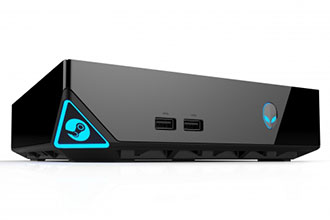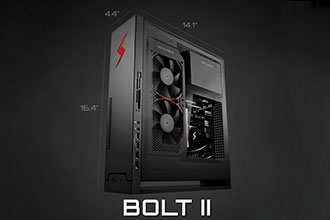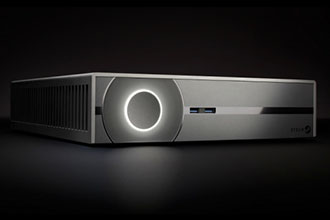Give Me Steam: Steam Boxes From An AV Perspective
 Perhaps the biggest story to come out of CES 2014 was the announcement of the Steam Boxes. Within hours of the initial press coverage, I was getting messages via social media from gamer friends who were, um, excited, to put it mildly.
Perhaps the biggest story to come out of CES 2014 was the announcement of the Steam Boxes. Within hours of the initial press coverage, I was getting messages via social media from gamer friends who were, um, excited, to put it mildly.
If you’re even half a gamer (or your kids are), you’re already aware of Steam, the online store-front which supports third-party developers and publishers that — according to market research — now accounts for a huge percentage of non-Apple OS online gaming.
Seeking to avoid the restrictions of both Apple’s and Microsoft’s online ecosystems, Steam Corp has gone off on its own, developing Steam OS, a Linux based platform that gives them the independence to develop the concept of the Steam Box, what one friend of mine described as being “like Apple TV, but for gaming.”
Unfortunately, that analogy runs out of steam pretty quickly, pun intended.
Vexing is that at CES, Valve revealed no less than thirteen Steam Machine hardware partners, and made it clear that more are welcome to join the party.
 Adding to the confusion is that not all of the specifications of the units that showed at CES have been finalized, walking that fine line between vaporware, CES-only science experiment, and that rarest of all CES babies: an actual, real product that will actually launch.
Adding to the confusion is that not all of the specifications of the units that showed at CES have been finalized, walking that fine line between vaporware, CES-only science experiment, and that rarest of all CES babies: an actual, real product that will actually launch.
I’m not going to deliver a rundown of the comparative specs of the initial 13 rival Steam Boxes since that’s a topic that’s already been flogged hard in the gamer press. But suffice it to say that the compare and contrast has more in common with the one-upsmanship of the PC market than it does with even game consoles or the TV spec wars that you’re all more familiar with. It’s all “8GB of DDR3 RAM, a 500 GB HDD and a 2GB AMD Radeon R9 270 graphics card “ versus “a quad-core Athlon X4 740 CPU and 4GB of RAM” over and over again.
It’s the kind of spec war that will make the eyes of even a die-hard nerd roll back into their head.
 And then other competitors go completely bonkers, like Digital Storm’s upper-tier Bolt II, a liquid cooled behemoth whose configurations include an Intel Core i7-4770k processor, Nvidia GTX 780 Ti graphics card, 16 GB of RAM, 120 GB SSD, a 1 TB hard drive, and a starting price of $,2600.
And then other competitors go completely bonkers, like Digital Storm’s upper-tier Bolt II, a liquid cooled behemoth whose configurations include an Intel Core i7-4770k processor, Nvidia GTX 780 Ti graphics card, 16 GB of RAM, 120 GB SSD, a 1 TB hard drive, and a starting price of $,2600.
So where does Steam fit into the working lives of AV Pros?
The short answer: I don’t yet know.
It’s a safe bet that residential AV pros are going to be asked to incorporate Steam Boxes into large screen media room designs. In fact, I’d bet it’s already happened.
But where does the opportunity lie?
Probably not in selling Steam Boxes to your customers. One media commentator pointed out that these devices were indistinguishable from a baker’s dozen of custom built PCs. It’s also been pointed out several times that all it takes to be a “Steam Box” is to run Linux and include a graphics processor, which describes basically every PC today. From what I can see, it looks like the biggest competitor to the OEM Steam Box vendors who’ve already thrown their hats into the ring is going to be TigerDirect.com.
Not only do Steam Boxes seem to be ruled out as a profit source, they don’t seem all that different from incorporating an XBox or Playstation into your average AV install: HDMI to the display, SPDIF to the surround processor. Ta da. So it’s not like there’s going to be six hours of install and programming labor attached to one. Yet, like traditional consoles, AV Pros are going to be burdened with a certain degree of ownership of the box if something goes wrong with the system.
 At least at the moment, the upside I see for AV Pros is in the “Wow” factor. Gaming via Steam Box on a giant screen in a dedicated Media Room is one more exciting reason for clients to open up their checkbook.
At least at the moment, the upside I see for AV Pros is in the “Wow” factor. Gaming via Steam Box on a giant screen in a dedicated Media Room is one more exciting reason for clients to open up their checkbook.
And that’s not a bad thing. It would probably behoove AV Pros who have a dedicated showroom to install a Steam Box into their rack and demonstrate it in action on the big screen.
Naturally, it’s still early. Perhaps we’ll see a consolidation of hardware, perhaps Steam Corp will dictate further standards, and perhaps there will be a few winners that will simplify the hardware choices presently available. And maybe further changes will make Steam more attractive, relevant and profitable to AV Pros than they are now.
We’ll see.





